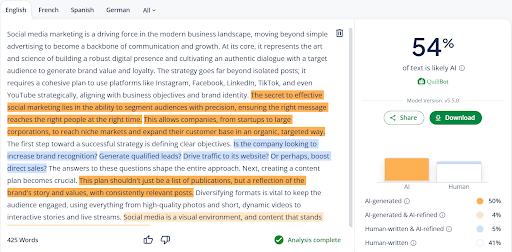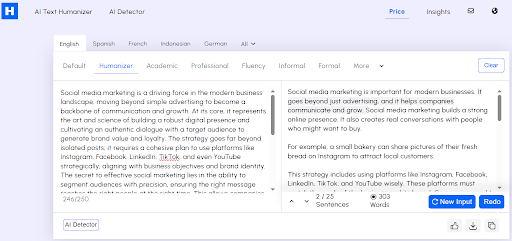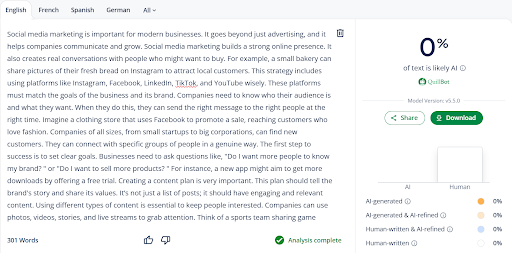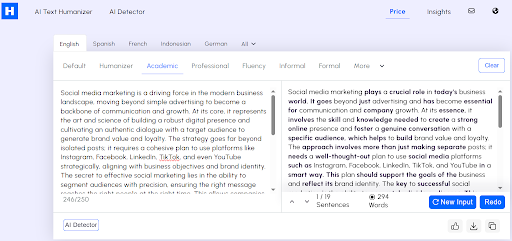The Ultimate Guide: How to Humanize AI Content Step by Step with Humanizador.net
Learn how to humanize AI content step by step with Humanizador.net. Make text natural, readable, and SEO-friendly while engaging real readers.
94% of organizations are using AI for marketing content in 2025. But none of them use AI content directly.
In fact, 27% of companies have employees to review and edit AI content before it is used, says McKinsey and Company. Every customer service message and image on social media is carefully analyzed.
Because everyone knows that raw AI content is flagged by AI detectors. Then, even readers do not easily engage with it. That’s why humanizing AI content is no longer optional.
Humanizador.net steps in to solve this challenge. It mimics human writing style to turn AI drafts into natural and content—without losing the original meaning. However, that is not all. It needs human input as well.
This guide will show you a step-by-step process to properly humanize AI content. So it feels like a real person wrote it.
How to humanize AI content step by step
Before diving into the steps, it’s important to understand that humanizing AI content is more than just changing a few words. It’s about adding the uniqueness that a human brings to the writing. That is beyond rewriting, simplifying, or just making it conversational.
Each step in this guide focuses on a different aspect of humanization. So that your content not only bypasses AI detectors, but also becomes valuable for your readers.
1. Analyze the AI-generated content
First of all, you need to read and understand the AI-generated text carefully. Even before checking it with any AI detector, you will be able to identify repetitions, fluff, and dullness.
Exactly what AI detectors look for and highlight in an AI-written text. Studies reveal that almost 50% of consumers can identify AI text by just analyzing it.
But it is still better to detect AI using a tool. Their accuracy is much better than ours (84%). Plus, they can pinpoint sentences that have AI similarities.
This initial assessment helps determine where improvements are needed. Sets the foundation for a truly humanized version of the content.
2. Humanize with humanizador.net
The next step is to use humanizador.net on the highlighted sentences. You just have to paste them into the tool. It will return them in a natural, conversational tone.
Humanizador can understand your context with its natural language processing technology. So it does not just change a few words and call it a new version.
It rewrites the whole passage in the same context from scratch. Uses simple sentence structures and words that we use in our daily conversations. This way, the results not only look human, but also sound like it.
3. Adjust tone and style
The process so far is enough to avoid most AI detectors in the market. But not enough to satisfy Google and your readers. They need more from you to like it.
First of all, you need to match your tone and style with your target audience. For example:
- Professional tone for LinkedIn posts or business communications
- Casual or friendly tone for social media marketing
- Persuasive tone for advertisement and email marketing
- Academic tone for research papers
The simplest way is to select your tone while humanizing with humanizador.net. It offers most of the tones that we use.
But if you want a different tone, it will not be as difficult because the content is already simplified by the humanizer.
4. Add your personal voice
The content is much better than before, but still not unique. It will stand out only after you add your ideas or perspectives to it.
People like to read others' opinions on things. So if you have any personal thoughts or experiences about the topic, do not hesitate to discuss. It will make the text feel like it was written by an expert rather than generated by software. That will be the most valuable thing in your content.
Google even ranks your content based on that. They call it EEAT (Experience, Expertise, Authoritativeness, and Trustworthiness). And reward sites with better SERP ranking that have it in their content.
5. Try to present facts in examples and stories
This one might be an extra step, but it can make your content extraordinary. It is said that humans are 22 times more likely to remember a fact told in a story than a simple fact.
So if you can explain concepts or instructions through real-life situations or stories, your readers will connect better and retain more information.
For example, you want to simply say, “Good SEO improves traffic.” Present it in a short story where a blog got a 50% increase in visitors after optimizing its content.
This approach shows that you have practical knowledge of the topic. In fact, 75% of consumers think that brands should use storytelling in their marketing strategy. It enriches the experience for users and boosts the product perception by up to 2,706%.
A practical example is Nike. They rarely, if ever, focus their ads on the technical features of a shoe or a piece of clothing. Instead, their entire brand identity is built on stories of struggle, perseverance, and triumph.
6. Ensure logical flow and transitions
Simplifying content for humanizing, like removing fluff and making sentences shorter, is only a part of the job. The bigger part is to make it flow naturally. Means all the sentences should be connected and all the paragraphs should be connected.
Readers quickly lose interest if content jumps from topic to topic without smooth transitions. Proper flow makes the reading experience natural, just like a conversation.
Take the following passage, for example, “SEO improves traffic. Blogging is important. Use keywords carefully.” The sentences are short and simple. But still sounds robotic. Since the flow is not natural.
It should be, “SEO is crucial to drive traffic. But needs consistent blogging. It integrates our keywords naturally.”
Now this one is longer. Plus, some words seem extra. But that’s how we say things normally. This logical structure humanizes the text better.
7. Localize and customize content
Humanization is about sounding like a real human. But humans sound different in different regions of the world. So you need to localize your content as well. With local phrases, expressions, and cultural references.
That will connect better with the locals. A simple greeting or idiom can change how readers perceive your content.
For example, in English, “faucet” is used in the U.S., while “tap” is preferred in the U.K. Without this, even humanized text can feel distant or generic.
Humanizador.net makes this easier. Its language capabilities go beyond just rewriting. It can humanize content in multiple languages while using local expressions naturally. It adapts the tone, words, and idioms to fit the region. Whether it’s English, Spanish, Portuguese, or Italian. Makes the content feel truly native to your audience.
8. Integrate SEO without losing human touch
The efforts till now are great for the audience, the readers. But we still have to make your content reach the target audience. For that, it has to be SEO-friendly as well.
You need to find the words that your audience is using to search the internet. We call them keywords. Google matches content according to these words. So if you use them, your content will show up when someone searches on the internet.
However, do not overstuff; that backfires. The goal is to balance optimization with readability, so your audience feels engaged while search engines understand your relevance.
Means do not repeat “best running shoes” unnaturally in every sentence. Integrate it organically: “Looking for the best running shoes? Here’s how these top picks can improve your stride and comfort.” This way, you keep the content conversational and still target the keyword.
9. Test and refine
Not much to do here now. Pretty much everything is already done. Now you just have to give a final look at the text. Read aloud, maybe, or detect AI once more. If you do not find any shortcomings, publish it.
However, your job is not done after hitting publish. You need to test how it performs and refine it based on feedback. Keep an eye on Google Analytics to see how it is working. Look at metrics like bounce rate, average time on page, and conversion rates.
These numbers reveal whether your readers truly find the content engaging. For example, you notice that visitors are leaving after the first paragraph. It may signal that the introduction isn’t strong enough. Or if they stay but don’t take action, perhaps your call-to-action (CTA) needs to be clearer.
Humanizador.net improves readability and makes text natural. But refinement comes from analyzing real-world results. 77% of top-performing marketers rely on A/B testing.
This iterative process ensures your writing stays effective long-term.
Conclusion
Do you want to win trust, engagement, and rankings in 2025? Then humanization is a necessity. AI gives you speed, but lacks the personality and clarity that real readers (and Google) value most.
By following my step-by-step process, you can transform machine-written drafts into content that feels alive.
The beauty of humanizador.net is that it doesn’t just bypass AI detectors. It gives you a natural, readable, and region-specific text. Now you need to combine that with your insights. And your content will outperform in search and impress your readers.
Start humanizing today. Turn your AI-generated text into content that truly makes an impact.



